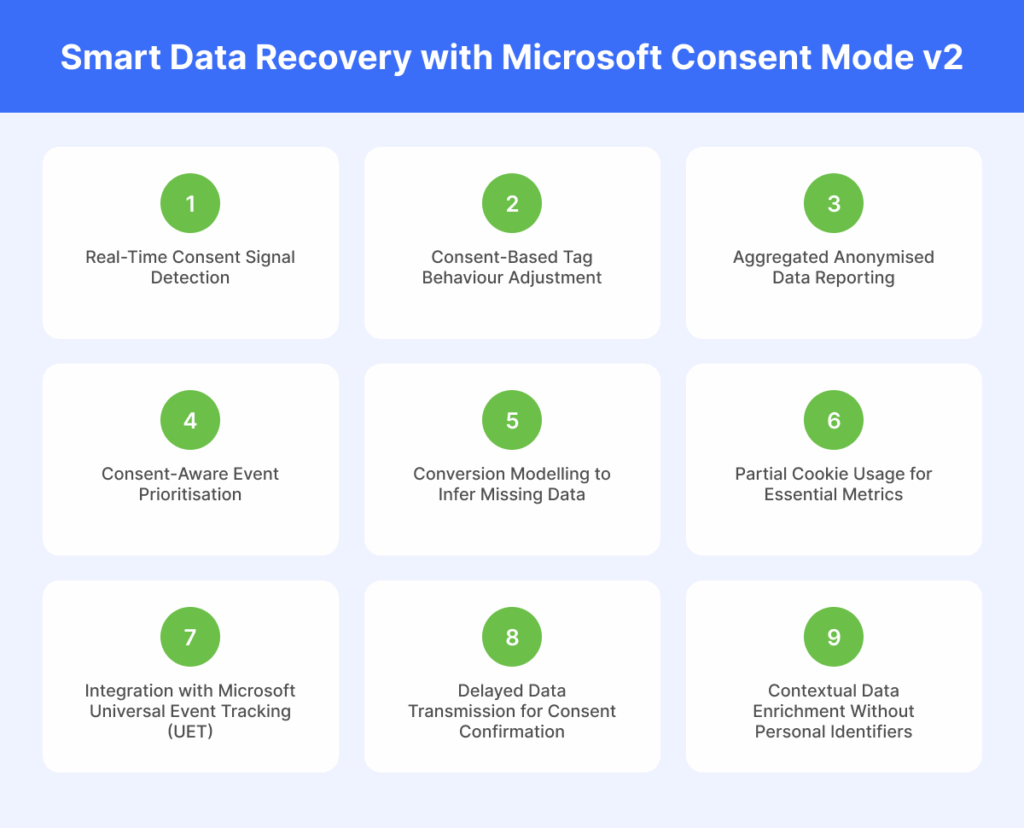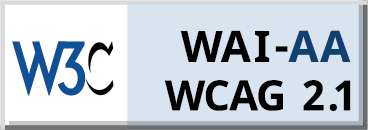Ever wondered how much marketing data goes missing when users reject cookies? As regulations like GDPR and the Digital Markets Act (DMA) compliance reshape data collection, marketers face a growing challenge—balancing user privacy with data needs.
Cookie refusals disrupt event tracking with consent, cripple audience segmentation recovery, and amplify attribution modeling challenges. But the story doesn’t end at a “no.”
With Microsoft Consent Mode v2, marketers now have a privacy-respecting way to recover hidden data in marketing and optimise performance. This blog explores how Microsoft helps marketers maintain accuracy, remain compliant, and regain insights even when full consent isn’t granted.
Microsoft Consent Mode v2 is a privacy-first framework that allows websites to adapt their data collection based on users’ consent choices. Instead of blocking all tracking when users opt out, the system adjusts, collecting limited, anonymised, or contextual data while supporting Microsoft privacy compliance. It provides flexible control over data collection and processing, depending on the user’s interaction with the consent banner.
The solution integrates seamlessly with advertising and analytics tools, ensuring continued event tracking with consent and helping marketers reduce data loss while staying compliant. For businesses relying on first-party data collection, this approach ensures they can still access valuable insights in real time, even when full consent isn’t granted.
Unlike traditional tracking tools, Microsoft Consent Mode v2 doesn’t bypass consent—it dynamically responds to it. When users decline consent, it restricts tracking scripts and instead gathers anonymised or contextual data. This ensures users’ preferences are fully respected while still capturing macro-level behavioural trends marketers can work with.
It also enables businesses to maintain visibility via Microsoft Universal Event Tracking, supporting Bing Ads conversion tracking and consent mode marketing strategies. By prioritising compliance and insight, it helps marketers unlock consent mode benefits even under privacy limitations.
User consent isn’t just a checkbox—it’s the gateway to collecting, processing, and using behavioural data within legal and ethical bounds. When users reject tracking, marketers instantly face setbacks like:
These challenges impact targeting, attribution, and ROI. Businesses are then forced into complex data recovery marketing methods just to maintain basic visibility, turning consent into a vital asset for marketing success.
Microsoft Consent Mode v2 actively detects and responds to real-time user consent choices, ensuring that event tracking with consent remains functional. This helps businesses maintain accuracy in their data even when users toggle their preferences at different interaction points.
This dynamic consent signal detection is essential for adapting the behaviour of tags and scripts on a website. It allows marketers to capture approved actions and suppress restricted ones, preserving the integrity of marketing data accuracy without breaching privacy.
Tag behaviour changes automatically depending on whether the user grants or denies consent. This enables full tracking, anonymised tracking, or completely paused tracking to match privacy preferences, unlocking significant consent mode benefits even under strict consent limitations.
Such automatic adjustments ensure that consent management doesn’t become a manual task. For marketers aiming to scale while remaining compliant, this seamless tag behaviour improves both operational efficiency and user trust.
Even when users decline consent, Microsoft Consent Mode v2 allows for anonymous, aggregated metrics that support privacy compliance marketing. This protects user identities while still giving marketers enough behavioural data to understand patterns.
Instead of zero visibility, marketers receive high-level insights that guide strategic decisions. This level of data is sufficient for campaign optimisation without requiring direct identifiers—an important element in consent-mode marketing.
Microsoft prioritises essential user actions, like purchases or signups, even when detailed consent isn’t given. This is done through privacy-respecting event logging that fuels data recovery marketing strategies without breaching regulations.
By focusing on high-value events that are critical to the business, Microsoft helps marketers retain core insights and measure outcomes with minimal data, balancing both privacy and performance.
Using advanced AI, Microsoft Consent Mode v2 performs conversion modelling by analysing historical patterns. This allows for the recovery of trends that would otherwise be lost due to consent limitations, solving attribution modelling challenges effectively.
The use of probabilistic and machine learning models bridges the data gap created by rejected cookies, helping marketers maintain attribution accuracy across their campaigns.
Rather than stopping all cookies, Microsoft enables limited first-party data collection for essential metrics like session duration, bounce rate, and engagement. These small insights are vital for ongoing performance analysis.
This approach ensures that core operational data is preserved, empowering marketers with a foundation of analytics even when broader tracking is restricted. It supports continuity without compromising privacy.
Microsoft Consent Mode v2 is fully compatible with Microsoft Universal Event Tracking (UET). UET tags adapt based on consent, supporting accurate Bing Ads conversion tracking while respecting user preferences.
This integration means that businesses running Microsoft Ads campaigns don’t lose critical data. Instead, they enjoy a consent-compliant way of continuing performance measurement with precision.
If a user’s consent status isn’t yet clear, Microsoft temporarily delays data transmission. This prevents premature data sharing, reducing consent mode for data loss risks while enhancing transparency.
The wait-and-see approach provides marketers with peace of mind, ensuring that data is only transmitted when user permission is explicitly granted, upholding both compliance and user trust.
Even when full consent is not given, Microsoft can enrich anonymised data with contextual signals like device type or session time, avoiding identifiers while supporting pattern analysis.
This helps marketers understand audience behaviour trends without collecting personal information, unlocking value through smart audience segmentation recovery that adheres to data protection regulations.

By adopting Microsoft’s solution, marketers gain a significant competitive edge in today’s privacy-first digital world. Whether dealing with limited tracking or adapting to regional compliance standards, Microsoft’s tools help businesses recover insights they’d otherwise lose.
Here’s how it empowers performance-focused teams without breaching consent boundaries:
These features collectively ensure a stronger return on ad spend, improved targeting precision, and long-term adaptability to future privacy regulations and technological shifts.
Microsoft Consent Mode v2 helps marketers recover lost marketing data while ensuring Microsoft privacy compliance. It supports Bing Ads conversion tracking and enables accurate event tracking with consent, balancing user privacy and first-party data collection for smarter, compliant marketing insights.
Looking forward, Consent Mode will evolve with AI-powered features and stronger cookieless tracking solutions. It will enhance consent mode marketing, address attribution modelling challenges, and ensure compliance with Global privacy laws, securing future-ready data recovery.
Stop losing valuable insights due to consent restrictions. Seers AI makes implementing Microsoft Consent Mode effortless, letting you recover hidden marketing data while staying fully compliant. Try using an AI-powered consent management solution today and unlock smarter, privacy-safe growth for your campaigns—try it now!
Start Free NowMicrosoft Consent Mode adjusts tracking based on user consent, allowing marketers to collect anonymised or partial data instead of losing it completely. This ensures more accurate event tracking, better audience segmentation recovery, and reliable attribution modelling despite consent restrictions.
Yes. Microsoft Consent Mode uses conversion modelling and aggregated anonymised data to estimate conversions missed due to consent denial. This helps marketers maintain campaign performance insights and improve Bing Ads conversion tracking accuracy.
By dynamically adjusting tag behaviour based on consent, Microsoft Consent Mode collects only privacy-compliant data, like anonymised events and first-party cookies. This balances user privacy with essential marketing data recovery under regulations like GDPR and the Digital Markets Act (DMA).
UET integrates with Microsoft Consent Mode to capture user interactions and conversions accurately while respecting consent choices. This ensures marketers receive reliable event data for optimised campaigns and better ad performance reporting.
Marketers should integrate Consent Mode via Microsoft tools for consent management and sync it with UET and Bing Ads. Continuous monitoring helps ensure marketing data accuracy, enabling smarter, consent-aware marketing strategies that recover lost data efficiently.
 Rimsha Zafar
Rimsha ZafarRimsha is a Senior Content Writer at Seers AI with over 5 years of experience in advanced technologies and AI-driven tools. Her expertise as a research analyst shapes clear, thoughtful insights into responsible data use, trust, and future-facing technologies.
United Kingdom
24 Holborn Viaduct
London, EC1A 2BN

Seers Group © 2025 All Rights Reserved
Terms of use | Privacy policy | Cookie Policy | Sitemap | Do Not Sell or Share My Personal Information.
Let Seers AI automate your compliance setup in seconds